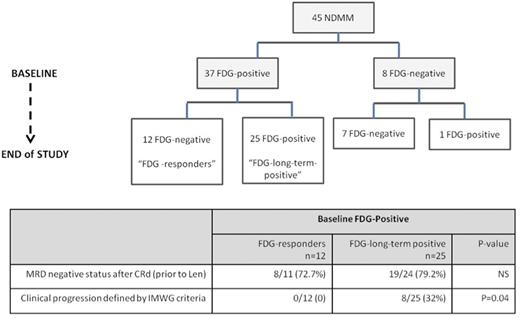Abstract
Introduction:
Multiple myeloma (MM) is a patchy bone marrow based malignancy of plasma cells, resulting in painful bone lytic lesions that can be visualized by 18F-FDG-PET-CT. We treated 45 NDMM patients with CRd-R therapy that resulted in high rates of minimal residual disease (MRD) negativity (62%)(Korde et al. JAMA Onc 2015). In this study, we assessed longitudinal FDG response through lenalidomide (Len) maintenance period and aimed to correlate with clinical findings and MRD status.
Methods:
The details of treatment received, study design and patients' characteristics have already been published. As part of the study design, all patients had serial PET imaging at baseline, after achievement of CR and/or at completion of 8 cycles of CRd, and at year-1 and -2 of Len maintenance, or termination of protocol therapy. Whole body (vertex to toes) static FDG imaging was performed at 1-hour post injection, implemented according to institutional practice. Focal lesions on FGD were defined as: increased uptake (above background reference) within the bone, (excluding articular regions due to high prevalence and likelihood of confounding arthritic disease), maximum standardized uptake value (SUV) >1.5 for lesion size on CT ranging from 0.5-1.0 cm, or maximum SUV >2.5 for lesions >1.0 cm.
Results:
At baseline, 37/45(82.2%) patients had FDG-positive lesions and 8/45(17.8%) were negative. Median follow-up for longitudinal analysis is 30.1 months. Among initial FDG-negative patients, 7/8 (87.5%) patients remained negative throughout follow-up; 1/8 (12.5%) patients developed a sclerotic FDG-positive lesion deemed not to be progression (rib 5 SUV 1.7). Among the 37 patients with baseline FDG-positive lesions, 12/37(32.4%) patients had complete resolution of FDG-PET-CTs (FDG-responders); 25/37(67.5%) remained FDG-long-term positive at time of last protocol scan. Eight of the 25(32%) FDG-long-term positive patients met IMWG criteria for progression, compared to 0/12 FDG-responders (p value=0.04). For patients with available data, MRD negative status after initial CRd (prior to Len maintenance) was not associated with long-term PET-CT response [19/24(79.2%) vs. 8/11(72.7%), FDG-long-term positive vs. FDG-responders, p=NS]. For the remaining FDG-long-term positive patients not meeting progression criteria, all 17 patients had low-positive persistent FDG with decreased or partial SUV response that decreased over time while on Len maintenance.
Conclusions:
In patients receiving CRd followed by long-term Len maintenance, 68% of baseline FDG-positive patients have persistent longitudinal FDG-positive myeloma lesions. While there is an increased risk of clinical progression among these patients, the majority showed low-positive FDG lesion uptake that decreased over time with long-term Len maintenance. Long-term resolution of FDG-positive lesions is not associated with MRD status after initial CRd therapy. Further follow-up is needed to examine the significance of persistent FDG-positive lesions in relationship to residual disease and mechanisms of resistance.
Korde:Medscape: Honoraria. Hassoun:Takeda: Consultancy, Research Funding; Celgene: Research Funding; Novartis: Consultancy; Binding Site: Research Funding. Landgren:Medscape Myeloma Program: Honoraria; BMS: Honoraria; Merck: Honoraria; Takeda: Honoraria; Amgen: Honoraria, Research Funding; Celgene: Honoraria, Research Funding.
Author notes
Asterisk with author names denotes non-ASH members.


This feature is available to Subscribers Only
Sign In or Create an Account Close Modal